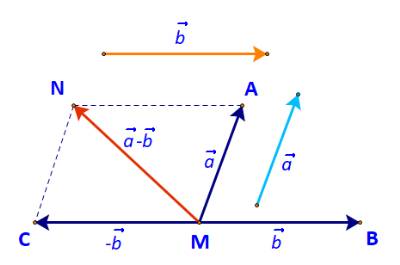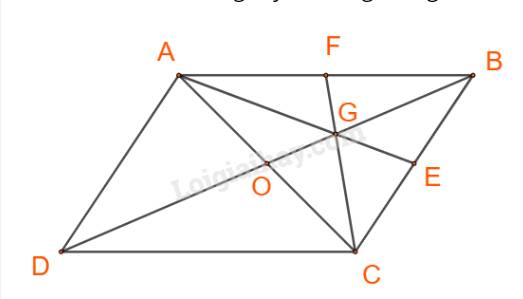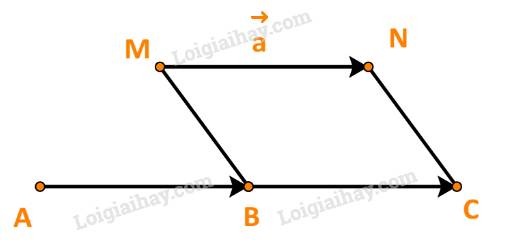Cho hai vecto \(\overrightarrow a ,\overrightarrow b \). Lấy một điểm A tùy ý.
a) Vẽ \(\overrightarrow {AB} = a\), \(\overrightarrow {BC} = b\)
b) Tổng của hai vecto \(\overrightarrow a \) và \(\overrightarrow b \)bằng vecto nào?
Hãy nhập câu hỏi của bạn vào đây, nếu là tài khoản VIP, bạn sẽ được ưu tiên trả lời.

a) Đặt D, E lần lượt là điểm đầu và điểm cuối của vecto \(\overrightarrow a \).
Ta có: \(\overrightarrow {MA} = \overrightarrow a \)hay \(\overrightarrow {MA} = \overrightarrow {DE} \)
\( \Leftrightarrow MAED\) là hình bình hành.
Do đó A là đỉnh thứ tư của hình bình hành tạo bởi vecto \(\overrightarrow a \)và điểm M.
Tương tự ta có:
B là đỉnh thứ tư của hình bình hành tạo bởi vecto \(\overrightarrow b \)và điểm M.
Lại có: \(\overrightarrow {MC} = - \overrightarrow b = - \overrightarrow {MB} \) do đó \(MC = MB\) và hai vecto \(\overrightarrow {MB} ,\overrightarrow {MC} \) ngược hướng nhau.
Hay M là trung điểm đoạn thẳng BC.

b) Lấy N là đỉnh thứ tư của hình bình hành AMCN.

Khi đó ta có: \(\overrightarrow {MA} + \overrightarrow {MC} = \overrightarrow {MN} \)
Mà: \(\overrightarrow {MA} = \overrightarrow a ;\;\overrightarrow {MC} = - \overrightarrow b \)
\( \Rightarrow \overrightarrow a + ( - \overrightarrow b ) = \overrightarrow {MN} \).

Cách 1:
Gọi O là giao điểm của AC và BD.

Ta có:
\(\begin{array}{l}\overrightarrow {AG} = \overrightarrow {AB} + \overrightarrow {BG} = \overrightarrow a + \overrightarrow {BG} ;\\\overrightarrow {CG} = \overrightarrow {CB} + \overrightarrow {BG} = \overrightarrow {DA} + \overrightarrow {BG} = - \overrightarrow b + \overrightarrow {BG} ;\end{array}\)(*)
Lại có: \(\overrightarrow {BD} =\overrightarrow {BA} + \overrightarrow {AD} = - \overrightarrow a + \overrightarrow b \).
\(\overrightarrow {BG} ,\overrightarrow {BD} \) cùng phương và \(\left| {\overrightarrow {BG} } \right| = \frac{2}{3}BO = \frac{1}{3}\left| {\overrightarrow {BD} } \right|\)
\( \Rightarrow \overrightarrow {BG} = \frac{1}{3}\overrightarrow {BD} = \frac{1}{3}\left( { - \overrightarrow a + \overrightarrow b } \right)\)
Do đó (*) \( \Leftrightarrow \left\{ \begin{array}{l}\overrightarrow {AG} = \overrightarrow a + \overrightarrow {BG} = \overrightarrow a + \frac{1}{3}\left( { - \overrightarrow a + \overrightarrow b } \right) = \frac{2}{3}\overrightarrow a + \frac{1}{3}\overrightarrow b ;\\\overrightarrow {CG} = -\overrightarrow b + \overrightarrow {BG} = -\overrightarrow b + \frac{1}{3}\left( { - \overrightarrow a + \overrightarrow b } \right) = - \frac{1}{3}\overrightarrow a - \frac{2}{3}\overrightarrow b ;\end{array} \right.\)
Vậy \(\overrightarrow {AG} = \frac{2}{3}\overrightarrow a + \frac{1}{3}\overrightarrow b ;\;\overrightarrow {CG} = - \frac{1}{3}\overrightarrow a - \frac{2}{3}\overrightarrow b .\)
Cách 2:
Gọi AE, CF là các trung tuyến trong tam giác ABC.

Ta có:
\(\overrightarrow {AG} = \frac{2}{3}\overrightarrow {AE} = \frac{2}{3}.\frac{1}{2}\left( {\overrightarrow {AB} + \overrightarrow {AC} } \right) = \frac{2}{3}.\frac{1}{2}\left[ {\overrightarrow {AB} + \left( {\overrightarrow {AB} + \overrightarrow {AD} } \right)} \right] \\= \frac{1}{3}\left( {2\overrightarrow a + \overrightarrow b } \right) = \frac{2}{3}\overrightarrow a + \frac{1}{3}\overrightarrow b \)
\(\overrightarrow {CG} = \frac{2}{3}\overrightarrow {CF} = \frac{2}{3}.\frac{1}{2}\left( {\overrightarrow {CA} + \overrightarrow {CB} } \right) = \frac{2}{3}.\frac{1}{2}\left[ {\left( {\overrightarrow {CB} + \overrightarrow {CD} } \right) + \overrightarrow {CB} } \right] = \frac{1}{3}\left( {2\overrightarrow {CB} + \overrightarrow {CD} } \right) = \frac{1}{3}\left( { - 2\overrightarrow {AD} - \overrightarrow {AB} } \right) = - \frac{1}{3}\overrightarrow a - \frac{2}{3}\overrightarrow b \)
Vậy \(\overrightarrow {AG} = \frac{2}{3}\overrightarrow a + \frac{1}{3}\overrightarrow b ;\;\overrightarrow {CG} = - \frac{1}{3}\overrightarrow a - \frac{2}{3}\overrightarrow b .\)

Bước 1: Dựng hình bình hành có cạnh song song với giá của vecto \(\overrightarrow a ,\;\overrightarrow b \) và đường chéo là vecto \(\overrightarrow u ,\;\overrightarrow v \).
Ta dựng được hình hình hành ABCD và DEGH. Trong đó: DC và DE nằm trên giá của vecto \(\overrightarrow a \), DA và DH nằm trên giá của vecto \(\overrightarrow b \), còn vecto \(\overrightarrow u ,\;\overrightarrow v \) lần lượt là hai dường chéo.
Dễ thấy: \(\overrightarrow u = \overrightarrow {DA} + \overrightarrow {DC} ,\;\overrightarrow v = \overrightarrow {DH} + \overrightarrow {DE} \)
Mà \(\overrightarrow {DA} = 3\overrightarrow b ,\;\overrightarrow {DC} = \overrightarrow a \;,\;\overrightarrow {DH} = 3\overrightarrow b ,\;\overrightarrow {DE} = - 2\overrightarrow a .\)
\( \Rightarrow \overrightarrow u = 2\overrightarrow b + \overrightarrow a ,\;\,\overrightarrow v = 3\overrightarrow b - 2\overrightarrow a \)

\(\begin{array}{l}{ + \, (\overrightarrow a + \overrightarrow b )^2} = (\overrightarrow a + \overrightarrow b )(\overrightarrow a + \overrightarrow b )\\ = \overrightarrow a .(\overrightarrow a + \overrightarrow b ) + \overrightarrow b .(\overrightarrow a + \overrightarrow b ) \\= {\overrightarrow a ^2} + \overrightarrow a .\overrightarrow b + \overrightarrow b .\overrightarrow a + {\overrightarrow b ^2} \\= {\overrightarrow a ^2} + 2\overrightarrow a .\overrightarrow b + {\overrightarrow b ^2}.\\ + \, {(\overrightarrow a - \overrightarrow b )^2} =(\overrightarrow a - \overrightarrow b )(\overrightarrow a - \overrightarrow b )\\ = \overrightarrow a .(\overrightarrow a - \overrightarrow b ) - \overrightarrow b .(\overrightarrow a - \overrightarrow b ) \\= {\overrightarrow a ^2} - \overrightarrow a .\overrightarrow b - \overrightarrow b .\overrightarrow a + {\overrightarrow b ^2} \\= {\overrightarrow a ^2} - 2\overrightarrow a .\overrightarrow b + {\overrightarrow b ^2}. \\ + \, (\overrightarrow a - \overrightarrow b )(\overrightarrow a + \overrightarrow b ) \\= \overrightarrow a .(\overrightarrow a - \overrightarrow b ) + \overrightarrow b .(\overrightarrow a - \overrightarrow b ) \\= {\overrightarrow a ^2} - \overrightarrow a .\overrightarrow b + \overrightarrow b .\overrightarrow a - {\overrightarrow b ^2} \\= {\overrightarrow a ^2} - {\overrightarrow b ^2}.\end{array}\)

Tham khảo:

Gọi M, N lần lượt là điểm đầu và điểm cuối của vecto \(\overrightarrow a \).
Từ B, M, N ta dựng hình bình hành BMNC.
Khi đó: \(\overrightarrow {MN} = \overrightarrow {BC} \) hay \(\overrightarrow a = \overrightarrow {BC} \).
\( \Rightarrow \overrightarrow a + \overrightarrow a = \overrightarrow {AB} + \overrightarrow {BC} = \overrightarrow {AC} \)
a) Vì \(\overrightarrow {AB} = \overrightarrow a = \overrightarrow {BC} \) nên A, B, C thẳng hàng và B là trung điểm của AC.
Vậy \(\overrightarrow a + \overrightarrow a \) và \(\overrightarrow {AB} \) cùng hướng, \(\left| {\overrightarrow a + \overrightarrow a } \right| = 2.\left| {\overrightarrow {AB} } \right|\)
b) Ta có: \(\overrightarrow a + \overrightarrow a \) và \(\overrightarrow {AB} \) cùng hướng, \(\left| {\overrightarrow a + \overrightarrow a } \right| = 2.\left| {\overrightarrow {AB} } \right|\)
Mà \(\overrightarrow {AB} = \overrightarrow a \) nên: \(\overrightarrow a + \overrightarrow a \) và \(\overrightarrow a \) cùng hướng, \(\left| {\overrightarrow a + \overrightarrow a } \right| = 2.\left| {\overrightarrow a } \right|\).

a) Ta có: \(\left\{ \begin{array}{l}AD//BC\\AD = BC\end{array} \right.\) (do tứ giác ABCD là hình bình hành)
\( \Rightarrow \overrightarrow {AD} = \overrightarrow {BC} \)
b) Ta có: \(\overrightarrow {AB} + \overrightarrow {AD} = \overrightarrow {AB} + \overrightarrow {BC} = \overrightarrow {AC} \)

\(\overrightarrow{x}\) ⊥ \(\overrightarrow{y}\)
⇒ \(\left(\overrightarrow{a}+\overrightarrow{b}\right)\left(\overrightarrow{2a}-\overrightarrow{b}\right)=0\). Đặt \(\left|\overrightarrow{a}\right|=a;\left|\overrightarrow{b}\right|=b\)
⇒ 2a2 - \(\overrightarrow{a}.\overrightarrow{b}\) + 2\(\overrightarrow{a}.\overrightarrow{b}\) - b2 = 0
⇒ \(\overrightarrow{a}.\overrightarrow{b}\) = b2 - 2a2 = 4 - 4 = 0
⇒ \(\left(\overrightarrow{a};\overrightarrow{b}\right)=90^0\)

a) Nếu A, B, C thẳng hàng thì đường thẳng AB trùng đường thẳng AC, do đó hai vecto \(\overrightarrow {AB} ,\overrightarrow {AC} \) cùng phương.
b) Nếu hai vecto \(\overrightarrow {AB} ,\overrightarrow {AC} \) cùng phương thì đường thẳng AB trùng đường thẳng AC, do đó ba điểm A, B, C có thẳng hàng.
a) Gọi M, N lần lượt là điểm đầu và điểm cuối của vecto \(\overrightarrow a \).
Vì \(\overrightarrow a = \overrightarrow {AB} \Leftrightarrow \overrightarrow {MN} = \overrightarrow {AB} \) nên tứ giác MNBA là hình bình hành.
Nói cách khác B là đỉnh thứ tư của hình bình hành tạo bởi vecto \(\overrightarrow a \) và điểm A.
Tương tự, C là đỉnh thứ tư của hình bình hành tạo bởi vecto \(\overrightarrow b \) và điểm B.
b) Dễ thấy: tổng của hai vecto \(\overrightarrow {AB} \) và \(\overrightarrow {BC} \) là vecto \(\overrightarrow {AC} \).
Do đó tổng của hai vecto \(\overrightarrow a \) và \(\overrightarrow b \)bằng vecto \(\overrightarrow {AC} \).
Ta có viết: \(\overrightarrow a + \overrightarrow b = \overrightarrow {AB} + \overrightarrow {BC} = \overrightarrow {AC} \)